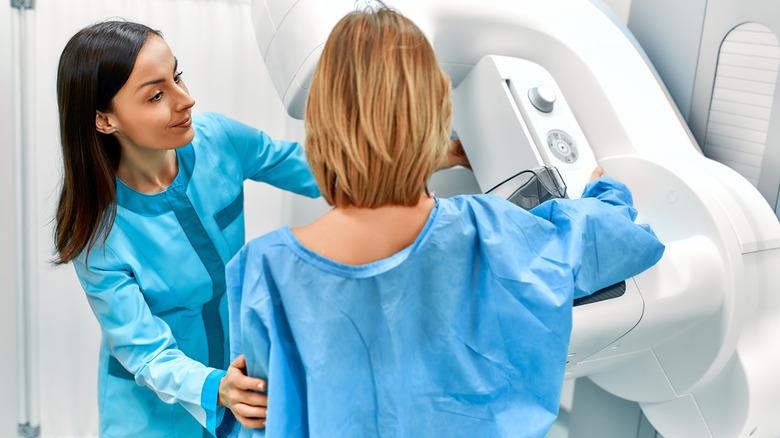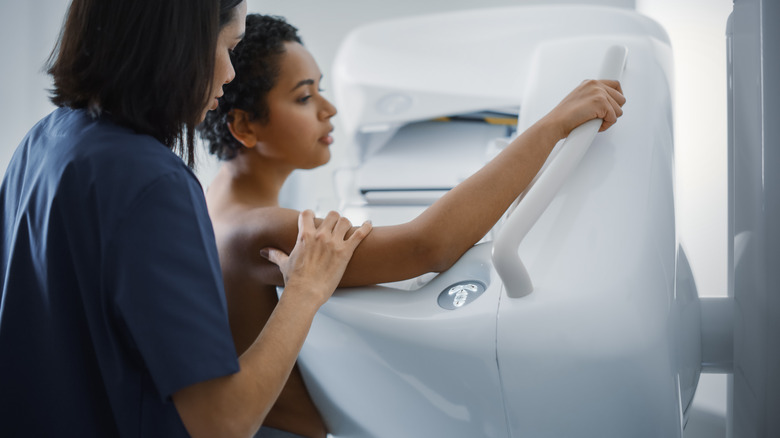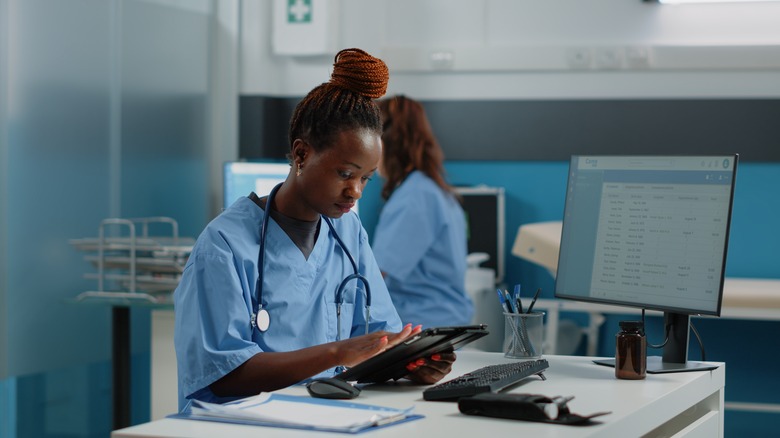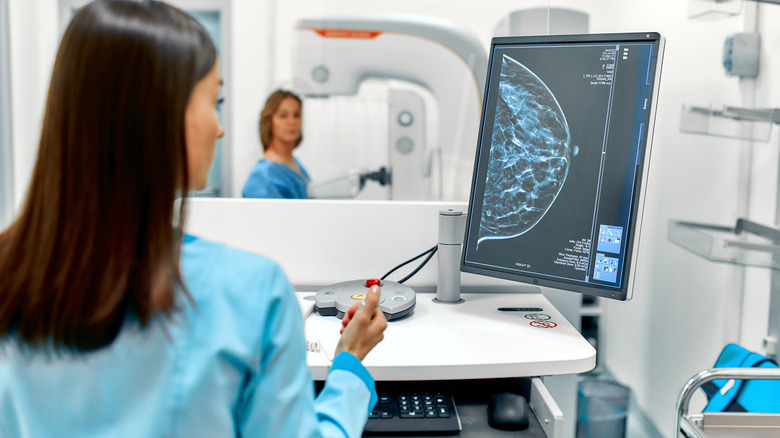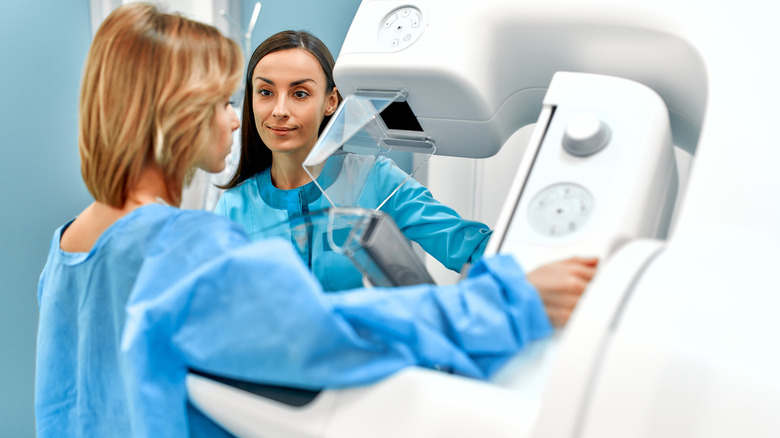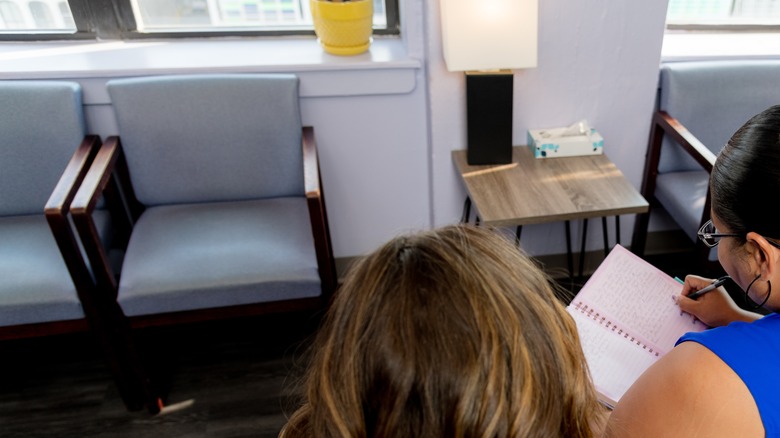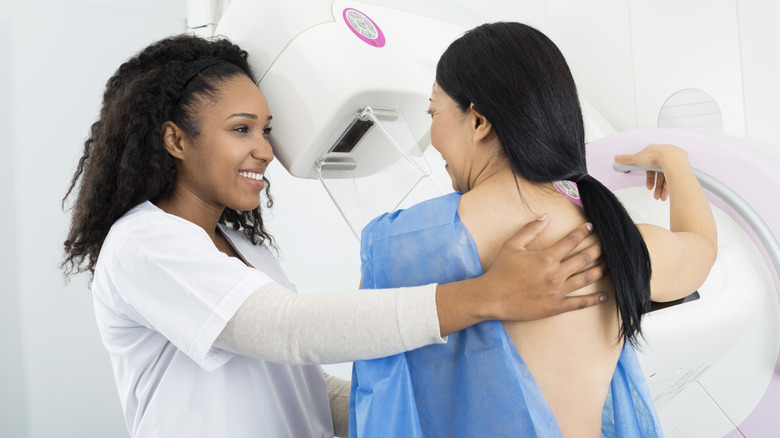Tips On Preparing For A Mammogram
Once you hit age 50, current recommendations for women with breast tissue are that you should get a mammogram every two years. If you're under 50 but have risk factors for breast cancer, your doctor may also recommend mammography at determined intervals. Getting a mammogram for the first time — or the fifth time — can be a little scary. You might put it off because it's uncomfortable or you don't know what to expect. But don't. According to the American Cancer Society, breast cancer is the most common type of cancer affecting women in the United States, and it accounts for 30% of cancer diagnoses in females every year.
The Centers for Disease Control and Prevention (CDC) reports that mammograms are currently the most effective way to discover breast cancer when tumors are still small enough that you can't feel them and they don't cause symptoms. Through mammography, breast cancer can sometimes be detected up to three years before you would be able to feel it. Waiting too long can make breast cancer more difficult to treat — and more deadly.
Mammograms can be a pain — literally. But knowing what to expect and how to prepare for your appointment can help reduce the anxiety and increase the ease of getting regular, potentially life-saving, screenings.
Know what to expect
A mammogram is a procedure in which X-ray images are taken of the breast tissue. It is a low-dose, digital X-ray that uses computer-aided detection (CAD) to enable radiologists to detect any abnormalities in the breast (via UConn Health). It can be either routine screening for women who don't have any symptoms or lumps that are detectable by touch, or it can be a diagnostic procedure for women who do have symptoms and/or lumps. The procedure differs slightly depending on whether it is routine or diagnostic. A diagnostic mammogram uses special techniques to capture more detailed images of the breast tissue (via the National Breast Cancer Foundation, Inc.).
The basic procedure is the same: A special machine is used to secure each breast in place. A technologist will place one breast on a plastic plate and then maneuver a second plate from above to press down firmly on the breast. This flattens the breast and makes it thinner so the X-rays can more easily penetrate the breast tissue. The plates also secure the breast so that it doesn't move, as movement can cause images to be blurred.
The technologist will capture the image, then readjust your breast several times to get images from different angles. The same procedure will be repeated for the other breast. You will be told to stand still and hold your breath while each image is captured. The entire procedure takes about 20 minutes.
Choose the right imaging center
If it's your first time getting a mammogram or you have to choose a new facility for any reason, do your homework. Although it may be easiest to choose a center that's closest to your house, that's not always the best choice. First, ask your doctor for their recommendation. They may have a tried-and-tested facility that they refer their patients to. You can also ask friends and family for recommendations, and look up facilities online to read customer reviews.
Iowa Radiology also recommends finding a facility that has fellowship-trained radiology specialists. These providers have undergone one to two years of specialized training in addition to their residency training. One study found that these trained specialist have a track record of detecting a greater number of cancers, including early-stage cancers. They tend to recommend follow-up biopsies more often and have to recall patients for follow-up imaging less often than general radiologists.
Other questions to ask include what kind of imaging technology the facility has. A newer technology called breast tomosynthesis — 3D mammogram — is more accurate for detecting cancer if you have dense breast tissue than traditional mammography (via the Cleveland Clinic). Keep in mind that this isn't mandatory unless your doctor has recommended it. You'll also want to make sure that the center is able to provide follow-up procedures, such as breast MRI, ultrasound, or biopsy, should your screening results require it.
Schedule your screening when your breasts aren't tender
The pressure applied by the plates during a mammogram can be uncomfortable, but it is not usually painful. That really depends on the individual and their pain tolerance. However, hormonal fluctuations before and during your period can make your breasts more tender and make mammography more painful. To minimize your discomfort, schedule your procedure for the time of the month your breasts are least likely to be tender, which is the week after your period ends, according to the Mayo Clinic.
If you're not able to do that, or if you find mammograms painful even when you don't have your period, you can take an anti-inflammatory medication, such as ibuprofen, about an hour before your procedure (via Pure Mammography). Pain after the screening isn't likely, but if you do feel some you can take another dose of anti-inflammatory medication at the proper intervals for the remainder of the day. It's best to speak with your doctor first about what medications you should take.
Have your doctor send your past test imaging or bring it with you
It's important to give the facility enough information about your history before your appointment. If this is your first mammogram, those records may consist of any symptoms you have had in the past, any breast surgeries or other procedures you've had, or any other pertinent information pertaining to your breasts.
If you have already had one or more mammograms, your past results can be helpful for the radiologist to compare to your new test results. This is especially true if the imaging captures any abnormalities. It's better for the radiologist to have that information on hand rather than having to procure it after the procedure.
In many cases, your doctor can have your records sent over to the facility. If you have previously had mammography at a different facility and are going to a new one, you can request past imaging to be sent to the new facility. You can also request the images on a CD that you can bring with you to your appointment.
Skip the deodorant, antiperspirant, lotion, and perfumes
When you schedule your mammogram, you will be given brief instructions for how to prepare for your screening. This will always include a directive to avoid any deodorant or antiperspirant. You should also avoid using lotions, creams, perfumes, or other topical substances around your breast area and under your arms. This is because these products can contain aluminum particles, which can show up as small white dots on mammogram images. These could be mistaken for calcifications, which are deposits of calcium in breast tissue. Calcifications often show up on mammograms, especially in women over 50, and in most cases are nothing to worry about (via the Mayo Clinic). However, when they appear in particular patters, this could indicate abnormal pre-cancerous changes in the breast tissue.
Even if you forget, you'll be provided with a wet wipe in the changing room before your screening. Be sure to use this, and if it's not provided, ask for one. If you're heading back to work or off to run errands after your appointment, you can bring deodorant, lotion, and perfume with you to apply after your screening.
Wear the right outfit
Before your mammogram, you'll be asked to remove your shirt and bra and be provided with a robe to wear during your procedure. To make this as easy as possible, wear a two-piece outfit consisting of a separate top and bottom. If you wear a dress, bodysuit, or overalls, you'll have to remove your whole outfit. It's also best to not wear anything fussy with a lot of straps, ties, or buttons, so you can easily slip into and out of your top and bra without unnecessary stress.
The right footwear can also make your experience more comfortable. You will need to stand throughout your appointment — about 20 minutes — so heels are not your best option. You may also be asked to step forward or back, or to adjust your stance. Shoes with flat soles or small heels will make this a lot easier. If your chosen daily wear is heels, just bring a pair of slip-ons or sandals with you to the appointment and change into them beforehand.
Finally, you should avoid wearing necklaces, dangling earrings, or any other adornment that can interfere with access to your breast area. If you are wearing these to your appointment, remove them in the changing room and stow them in your purse or bag.
Tell the technologist any important information
Many mammogram appointments are quick, in-and-out, procedures. But don't hesitate to take a few minutes in the beginning of your appointment to tell your technologist any information you think they might need to know. If you have any mobility problems or trouble standing or walking, be sure to alert the technologist so they can provide more support. Tell your technologist if you have had any recent changes in your breasts or other related problems.
If you have breast implants, you should communicate this when you make the appointment and tell the technologist again before your procedure, because the technique used will be different. According to the American Cancer Society, women with breast implants require two additional images on each breast.
If you are pregnant or breastfeeding, that should also be reported to the technologist. Mammograms are safe during pregnancy and while nursing, but special precautions are taken. Although only a small amount of radiation is necessary during a mammography, when you are pregnant a lead shield will be placed across your belly to protect your womb. If you are breastfeeding, your breast tissue may be denser than normal (via Pure Mammography). It's important that the radiologist reviewing your images be knowledgeable about reading results from breastfeeding women.
Lastly, if you have gotten a tattoo anywhere on your body — not just on your chest — communicate that when you make the appointment and again before the procedure. Tattoo ink can migrate to lymph nodes in the body, and on a diagnostic image this can be mistaken for breast cancer (via MD Anderson Cancer Center).
Eat, drink, and take your medications as usual
Some medical testing procedures require you to skip food and drink in the hours before the test. Before a mammogram you can eat and drink as you normally do, with a couple of (optional) exceptions.
If you drink caffeine you may want to consider reducing the amount you consume or cutting it out completely for three to four days prior to your appointment. According to Pure Mammography, caffeine can increase breast tenderness and potentially make the mammogram more uncomfortable. Caffeine isn't just in coffee and tea; it's also in chocolate, soda, energy drinks, guarana, and some supplements.
Reducing sodium before your mammogram is also a good idea, notes Health Images. Excess sodium can cause water retention throughout the body, including the breast. This can cause increased pressure and potentially more discomfort when the breasts are compressed. Sodium is found in table salt as well as in most processed foods, including fast food, many restaurant meals, canned soups and vegetables, snack foods, lunch meats, and frozen dinners.
Practice relaxation techniques
Feeling nervous before a mammogram — especially your first — is totally normal. First of all, don't rush to your appointment, as that will increase your stress. Leave plenty of time to arrive at your appointment early.
Before you go to your appointment and while you're in the waiting room, you can practice some calming techniques to help reduce anxiety. Listen to some relaxing music on your way to your appointment, and bring some earphones so you can listen while you're in the waiting room.
Both in the car and in the waiting room, try some deep breathing techniques. According to a 2018 research review in Frontiers in Human Neuroscience, deep-breathing techniques activate the parasympathetic nervous system, which helps your body relax. You can simply take long, deep breaths through your nose and into your belly, then exhale slowly through your mouth, or you can try "box breathing." This method involves inhaling through the nose for a slow count of four, holding the breath for four seconds, exhaling slowly through your mouth for four seconds, then holding the breath again for four seconds. Repeat the steps three to four times (via the Cleveland Clinic).
Take someone with you
If getting a mammogram alone makes you feel nervous or uncomfortable, ask a friend or family member to accompany you. In most cases, they won't be able to come with you into the treatment room. However they can drive with you to the appointment, sit with you while you wait, and be there for you when you come out.
Although it's not common, The Washington Post reports that some facilities make special accommodations for "high-priority" cases. This might include breast cancer survivors and women who are having symptoms and undergoing a diagnostic procedure. Call the facility first to find out their policies for friends and family members accompanying you.
Another idea that could save lives: Hold your female friends and family members accountable for getting regular screening by making appointments together. You may be able to get back-to-back appointments if you schedule them far enough in advance. This means not only will you have someone to go with, but you'll also have someone with you who is going through the same experience.
Be prepared for paperwork
As with any medical procedure, you will need to fill out paperwork prior to or when you arrive at your appointment. If this is your first mammogram or you are getting a mammogram at a new facility, you will likely need to fill out more paperwork than normal. You may need some or all of the following: your personal ID, your medical ID (if you have one), your insurance card, your prescription for a mammogram or your doctor's order, records of your past mammogram results, and records of any health conditions or recent surgeries (via Women's Imaging Specialists).
To make sure you arrive with everything you need, inquire when you make the appointment or call ahead of time. Fill out any paperwork you are given beforehand several days in advance so you are not rushing to get it done the day of your appointment. Arrive to your appointment early so you have plenty of time to handle any additional paperwork without feeling hurried and stressed.
What to do during your appointment
You've prepared well for your appointment, but it doesn't stop there. Communication is key during your mammogram to make sure the procedure goes smoothly, the technologist has all the information they need, and that you feel as comfortable as possible. If you've chosen the right facility, then customer service and compassionate care will be something you can — and should — expect. Therefore, feel free to communicate any concerns or ask any questions you might have before the procedure. For example, you can ask again for a brief description of the process and what to expect if you need a little refresher.
You should also tell them if you are having any breast tenderness or pain. If at any point in the process you are experiencing pain, don't grin and bear it — tell your technologist. The same is true if you are feeling lightheaded or dizzy.
You can also request a slower, more gradual compression of the breast tissue, which can be less anxiety-provoking than the usual compression pace. Having some control over compression has been shown to reduce pain and increase patient satisfaction during the process (via Thaïs Aliabadi, MD). You can also ask for more time between images to readjust and relax.
What to do after your appointment
Mammograms can be stressful. Instead of rushing back to work, take a little time to relax, if possible. Have a nice lunch at your favorite restaurant, get a pedicure, or go home and take a warm bath. If you're having pain, refrain from activities that can worsen your discomfort. This includes anything strenuous such as exercise. You could take a relaxing walk or do some gentle yoga or stretching to get some movement while encouraging relaxation.
Do follow up. According to MD Anderson Cancer Center, if you're having a preventive screening, you may not receive your results for a few weeks. If you are having a mammogram for a specific reason — an identified lump or because you have a different type of cancer — you should receive results immediately. If not, call your doctor to make sure they've received the results. If you are required to go for a follow-up appointment, make it right away.
If you get called back, try not to worry. Getting called back is common and it doesn't mean you have breast cancer. Some women need a follow-up appointment because the pictures weren't clear and need to be retaken. In other cases, the radiologist sees something suspicious, but more often than not it turns out to be a calcification or a benign mass, such as a cyst. According to the American Cancer Society, fewer than 1 in 10 women who get called back for further testing are diagnosed with cancer.

